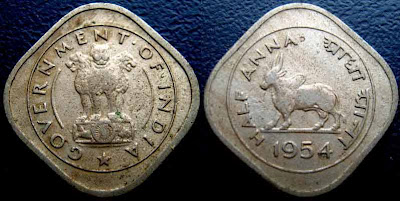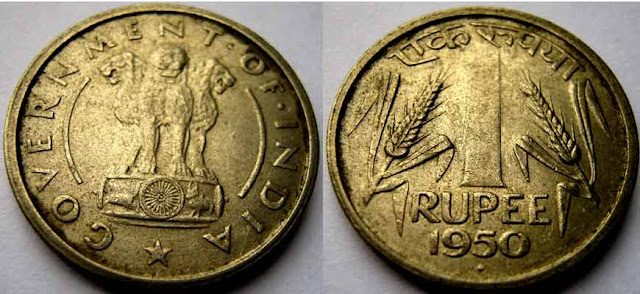REGULAR ANNA/ PICE SERIES COINS OF REPUBLIC OF INDIA
Anna / Pice Series
India attained her Independence on 15th August, 1947. But there was no immediate change in her coinage. In the years following the Independence, all the coins bearing the effigy of King George VI continued to be struck at the Indian mints with the frozen date ‘1947’.
On the 26th January, 1950, India declared herself to be a Republic. On 15th August, 1950 a new series of coins were issued with the design of ‘Lion Capital of Ashoka’ on the obverse. This series of coins were issued in the denomination of Single Pice, Half Anna, One Anna, Two Annas, Quarter Rupee, Half Rupee and One Rupee.
The Mumbai mint issued all the coins of this series. The mint mark of Mumbai mint is a diamond shaped dot. The Kolkata mint issued the Single Pice, Half Anna, Quarter Rupee, and Half Rupee coins only. There is no mint mark on issues of Kolkata mint. The Hyderabad mint issued the Single Pice coins only. The mint mark of Hyderabad mint is a diamond mint mark, split vertically.
One Pice
Years of issue – 1950 - 1955
Metal composition – Bronze (97% Copper + 2.5% Zinc + 0.5% Tin)
Weight – 60 grams (Thick coin, thickness – 1.6 mm, issued in 1950)
Metal composition – Bronze (97% Copper + 2.5% Zinc + 0.5% Tin)
Weight – 60 grams (Thick coin, thickness – 1.6 mm, issued in 1950)
- 45 grams (Thin coin, thickness – 1.2 mm, issued from 1951 to 1955)
Shape – Circular
Diameter – 0.84”
Shape – Circular
Diameter – 0.84”
Edge – unmilled plain
Obv – Lion capital of Ashoka, with legend ‘GOVERNMENT OF INDIA’ around periphery.
Rev – The center of this coin shows a replica of the horse, shown at the base of the Lion capital. The value of the coin in both English and Hindi, appears at the top of the periphery and the year of issue at the bottom.
Minted at – Mumbai(1950- 55), Kolkata(1950- 51,1953-54), Hyderabad(1953- 55)
Km Number – # 1
Note:
i) The issues of 1950, of this coin are found with both thick rim and thin hair line rim.
ii) The issues of 1950, of this coin, are all thick coins with thickness – 1.6 mm, weight – 60 grains.
iii) The issues of 1951 to 1955, of this coin, are all thin coins with thickness – 1.2 mm, weight – 45 grains.
Specifications
Years of issue – 1950, 1954 - 55
Metal composition – Copper – Nickel alloy (75% Copper + 25% Nickel)
Weight – 45 grains
Shape – Square with rounded corners
Diameter – 0.684” across sides, 0.778” across corners
Edge – unmilled plain
Obv – Lion capital of Ashoka, with legend ‘GOVERNMENT OF INDIA’ around periphery.
Rev – The center of this coin shows a replica of the bull, shown at the base of the Lion capital. The value of the coin in both English and Hindi, appears at the top of the periphery and the year of issue at the bottom.
Minted at – Mumbai(1950, 1954 - 55), Kolkata(1950, 1954)
Km Number – # 2
Specifications
Years of issue – 1950, 1954 - 55
Metal composition – Copper – Nickel alloy (75% Copper + 25% Nickel)
Weight – 60 grains
Shape – Scalloped (12 numbers)
Diameter – 0.7795” min, 0.827” max
Edge – unmilled plain
Obv – Lion capital of Ashoka, with legend ‘GOVERNMENT OF INDIA’ around periphery.
Rev – The center of this coin shows a replica of the bull, shown at the base of the Lion capital. The value of the coin in both English and Hindi, appears at the top of the periphery and the year of issue at the bottom.
Minted at – Mumbai
Km Number – # 3
Specifications
Years of issue – 1950, 1954 - 55
Metal composition – Copper– Nickel alloy (75% Copper + 25% Nickel)
Weight – 90 grains
Shape – Square with rounded corners
Diameter – 0.88” across sides, 1.00” across corners
Edge – unmilled plain
Obv – Lion capital of Ashoka, with legend ‘GOVERNMENT OF INDIA’ around periphery.
Rev – The center of this coin shows a replica of the bull, shown at the base of the Lion capital. The value of the coin in both English and Hindi, appears at the top of the periphery and the year of issue at the bottom.
Minted at – Mumbai
Km Number – # 4
Specifications
Years of issue – 1950 – 51, 1954 - 56
Metal composition – Nickel (100%)
Weight – 45 grains
Shape – Circular
Diameter – 0.75”
Edge – Milled
Obv – Lion capital of Ashoka, with legend ‘GOVERNMENT OF INDIA’ around periphery.
Rev – The center of this coin shows ¼, in international numerals between two ears of corn. The value of this coin in Hindi appears at the top of the periphery and the value in English and the year of issue appear under ¼ .
Minted at – Mumbai(1950 – 51, 1955), Kolkata(1950 - 51, 1955 - 56)
Km Number – # 5
Note:
i) The issues of 1954, of this coin, from Kolkata mint, are found with larger or smaller lion capital.
a) With dots after “GOVERNMENT” and “OF”
Specifications
Years of issue – 1950 – 51, 1954 - 55
Metal composition – Nickel (100%)
Weight – 90 grains
Shape – Circular
Diameter – 0.95”
Edge – Milled
Obv – Lion capital of Ashoka, with legend ‘GOVERNMENT . OF . INDIA’ around periphery(With dots).
Rev – The center of this coin shows ½, in international numerals between two ears of corn. The value of this coin in Hindi appears at the top of the periphery and the value in English and the year of issue appear under ½.
Minted at – Mumbai(1950 – 51, 1954 - 55), Kolkata(1950, 1954)
Km Number – # 6.2
b) Dots after “GOVERNMENT” and “OF” removed
Specifications
Year of issue – 1956
Obv – Lion capital of Ashoka redrawn, with legend ‘GOVERNMENT OFINDIA’ around periphery (Dots removed).
Minted at –Kolkata
Km Number – # 6.3
Specifications
Years of issue – 1950, 1954
Metal composition – Nickel (100%)
Weight – 180 grains
Shape – Circular
Diameter – 1.1”
Edge – Security
Obv – Lion capital of Ashoka, with legend ‘GOVERNMENT OF INDIA’ around periphery.
Rev – The center of this coin shows 1, in international numerals between two ears of corn. The value of this coin in Hindi appears at the top of the periphery and the value in English and the year of issue appear under 1.
Minted at – Mumbai
Km Number – # 7
Obv – Lion capital of Ashoka, with legend ‘GOVERNMENT OF INDIA’ around periphery.
Rev – The center of this coin shows a replica of the horse, shown at the base of the Lion capital. The value of the coin in both English and Hindi, appears at the top of the periphery and the year of issue at the bottom.
Minted at – Mumbai(1950- 55), Kolkata(1950- 51,1953-54), Hyderabad(1953- 55)
Km Number – # 1
Note:
i) The issues of 1950, of this coin are found with both thick rim and thin hair line rim.
ii) The issues of 1950, of this coin, are all thick coins with thickness – 1.6 mm, weight – 60 grains.
iii) The issues of 1951 to 1955, of this coin, are all thin coins with thickness – 1.2 mm, weight – 45 grains.
Half Anna
Specifications
Years of issue – 1950, 1954 - 55
Metal composition – Copper – Nickel alloy (75% Copper + 25% Nickel)
Weight – 45 grains
Shape – Square with rounded corners
Diameter – 0.684” across sides, 0.778” across corners
Edge – unmilled plain
Obv – Lion capital of Ashoka, with legend ‘GOVERNMENT OF INDIA’ around periphery.
Rev – The center of this coin shows a replica of the bull, shown at the base of the Lion capital. The value of the coin in both English and Hindi, appears at the top of the periphery and the year of issue at the bottom.
Minted at – Mumbai(1950, 1954 - 55), Kolkata(1950, 1954)
Km Number – # 2
One Anna
Specifications
Years of issue – 1950, 1954 - 55
Metal composition – Copper – Nickel alloy (75% Copper + 25% Nickel)
Weight – 60 grains
Shape – Scalloped (12 numbers)
Diameter – 0.7795” min, 0.827” max
Edge – unmilled plain
Obv – Lion capital of Ashoka, with legend ‘GOVERNMENT OF INDIA’ around periphery.
Rev – The center of this coin shows a replica of the bull, shown at the base of the Lion capital. The value of the coin in both English and Hindi, appears at the top of the periphery and the year of issue at the bottom.
Minted at – Mumbai
Km Number – # 3
Two Annas
Specifications
Years of issue – 1950, 1954 - 55
Metal composition – Copper– Nickel alloy (75% Copper + 25% Nickel)
Weight – 90 grains
Shape – Square with rounded corners
Diameter – 0.88” across sides, 1.00” across corners
Edge – unmilled plain
Obv – Lion capital of Ashoka, with legend ‘GOVERNMENT OF INDIA’ around periphery.
Rev – The center of this coin shows a replica of the bull, shown at the base of the Lion capital. The value of the coin in both English and Hindi, appears at the top of the periphery and the year of issue at the bottom.
Minted at – Mumbai
Km Number – # 4
Quarter Rupee
Years of issue – 1950 – 51, 1954 - 56
Metal composition – Nickel (100%)
Weight – 45 grains
Shape – Circular
Diameter – 0.75”
Edge – Milled
Obv – Lion capital of Ashoka, with legend ‘GOVERNMENT OF INDIA’ around periphery.
Rev – The center of this coin shows ¼, in international numerals between two ears of corn. The value of this coin in Hindi appears at the top of the periphery and the value in English and the year of issue appear under ¼ .
Minted at – Mumbai(1950 – 51, 1955), Kolkata(1950 - 51, 1955 - 56)
Km Number – # 5
Note:
i) The issues of 1954, of this coin, from Kolkata mint, are found with larger or smaller lion capital.
Half Rupee
Specifications
Years of issue – 1950 – 51, 1954 - 55
Metal composition – Nickel (100%)
Weight – 90 grains
Shape – Circular
Diameter – 0.95”
Edge – Milled
Obv – Lion capital of Ashoka, with legend ‘GOVERNMENT . OF . INDIA’ around periphery(With dots).
Rev – The center of this coin shows ½, in international numerals between two ears of corn. The value of this coin in Hindi appears at the top of the periphery and the value in English and the year of issue appear under ½.
Minted at – Mumbai(1950 – 51, 1954 - 55), Kolkata(1950, 1954)
Km Number – # 6.2
b) Dots after “GOVERNMENT” and “OF” removed
Specifications
Year of issue – 1956
Obv – Lion capital of Ashoka redrawn, with legend ‘GOVERNMENT OFINDIA’ around periphery (Dots removed).
Minted at –Kolkata
Km Number – # 6.3
One Rupee
Specifications
Years of issue – 1950, 1954
Metal composition – Nickel (100%)
Weight – 180 grains
Shape – Circular
Diameter – 1.1”
Edge – Security
Obv – Lion capital of Ashoka, with legend ‘GOVERNMENT OF INDIA’ around periphery.
Rev – The center of this coin shows 1, in international numerals between two ears of corn. The value of this coin in Hindi appears at the top of the periphery and the value in English and the year of issue appear under 1.
Minted at – Mumbai
Km Number – # 7

























































